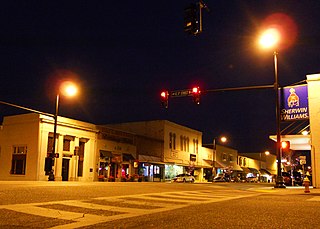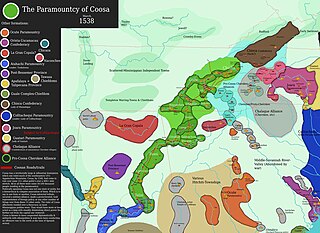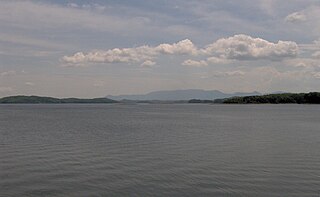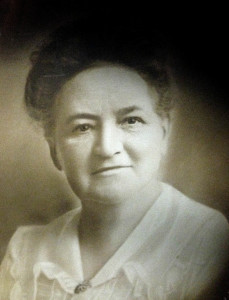
The Muscogee, also known as the Mvskoke, Muscogee Creek or just Creek, and the Muscogee Creek Confederacy, are a group of related Indigenous peoples of the Southeastern Woodlands in the United States. Their historical homelands are in what now comprises southern Tennessee, much of Alabama, western Georgia and parts of northern Florida.

Childersburg is a city in Talladega County in the U.S. state of Alabama. It was incorporated in 1889. At the 2020 census, the population was 4,754. It has a history dating back before 1540, when it was noted as a village of the Coosa Nation visited by the Spanish explorer Hernando de Soto. It is said a member of De Soto’s crew fell ill and was left to settle in the area of present day Childersburg where the Coosa people cared for the ill explorer. The Alabama Army Ammunition Plant, important during World War II, was located 4 miles (6 km) north of Childersburg.

Sylacauga is a city in Talladega County, Alabama, United States. At the 2020 census, the population was 12,578.
Crystal Cavern(s), also known throughout the years as Alabama Caverns and McClu(n)ney Cave, is a small cavern containing crystal formations located in Clay, Alabama, USA.

Etowah Indian Mounds (9BR1) are a 54-acre (220,000 m2) archaeological site in Bartow County, Georgia, south of Cartersville. Built and occupied in three phases, from 1000–1550 CE, the prehistoric site is located on the north shore of the Etowah River.

The Coosa River is a tributary of the Alabama River in the U.S. states of Alabama and Georgia. The river is about 280 miles (450 km) long.

Meramec Caverns is the collective name for a 4.6-mile (7.4 km) cavern system in the Ozarks, near Stanton, Missouri. The caverns were formed from the erosion of large limestone deposits over millions of years. Pre-Columbian Native American artifacts have been found in the caverns. Currently the cavern system is a tourist attraction, with more than fifty billboards along Interstate 44 and is considered one of the primary attractions along former U.S. Highway 66. Meramec Caverns is the most-visited cave in Missouri with some 150,000 visitors annually.
Sauta Cave National Wildlife Refuge is a 264-acre (107 ha) National Wildlife Refuge located in northeastern Alabama, near the Sauty Creek embayment of Guntersville Lake.

Tuskaloosa was a paramount chief of a Mississippian chiefdom in what is now the U.S. state of Alabama. His people were possibly ancestors to the several southern Native American confederacies who later emerged in the region. The modern city of Tuscaloosa, Alabama, is named for him.

The Coosa chiefdom was a powerful Native American paramount chiefdom in what are now Gordon and Murray counties in Georgia, in the United States. It was inhabited from about 1400 until about 1600, and dominated several smaller chiefdoms. The total population of Coosa's area of influence, reaching into present-day Tennessee and Alabama, has been estimated at 50,000.

Onondaga Cave State Park is a Missouri state park located on the Meramec River approximately 5 miles (8.0 km) southeast of the village of Leasburg. The park was established in 1982. Park activities include cave tours, camping, fishing, hiking, picnicking, and swimming.

Chiaha was a Native American chiefdom located in the lower French Broad River valley in modern East Tennessee, in the southeastern United States. They lived in raised structures within boundaries of several stable villages. These overlooked the fields of maize, beans, squash, and tobacco, among other plants which they cultivated. Chiaha was at the northern extreme of the paramount Coosa chiefdom's sphere of influence in the 16th century when the Spanish expeditions of Hernando de Soto and Juan Pardo passed through the area. The Chiaha chiefdom included parts of modern Jefferson and Sevier counties, and may have extended westward into Knox, Blount and Monroe counties.

The Old Spanish Treasure Cave is located on Hwy 59 between Sulphur Springs and Gravette, Arkansas in the northwest corner of the state. It has been a popular tourist attraction since at least 1908. It is still open to the public, with guided tours and other activities such as panning for treasure and finding fossils.
Manitou Cave is a cave in Alabama, near the town of Fort Payne, in the side of Lookout Mountain. In the early 1800s, the Fort Payne area was a Cherokee settlement named Willstown. This was the home of Sequoyah during his time of creating the Cherokee syllabary. Later, Sequoyah's son wrote on the walls of Manitou Cave using this syllabary, documenting ceremonial events and other culturally significant information and history. In the 1830s, Cherokee people were forcibly relocated from this area along the Trail of Tears, leaving the cave empty for some time. During the Civil War, the cave was a source of saltpeter for the Confederate Army. The mineral was mined by laborers to provide the essential ingredient for black powder. The cave was also designated fallout shelter during the Cold War.

Ida Elizabeth Brandon Mathis (1857–1925) was an American farmer and businesswoman who advocated for methods that would improve conditions for Southern farmers, including crop diversification and rotation and better methods of financing for small farmers. She is credited with reducing agricultural poverty in Alabama and diminishing the state's dependence on imported food.

The Taskigi Mound or Mound at Fort Toulouse – Fort Jackson Park (1EE1) is an archaeological site from the South Appalachian Mississippian Big Eddy phase. It is located on a 40 feet (12 m) bluff at the confluence of the Coosa and Tallapoosa rivers where they meet to form the Alabama River, near the town of Wetumpka in Elmore County, Alabama.

Selocta Chinnabee was a Muscogee and Natchez chief from present-day Talladega County, Alabama. He allied himself with the Andrew Jackson in fighting the Red Sticks in the Creek War, which was part of the larger War of 1812.














